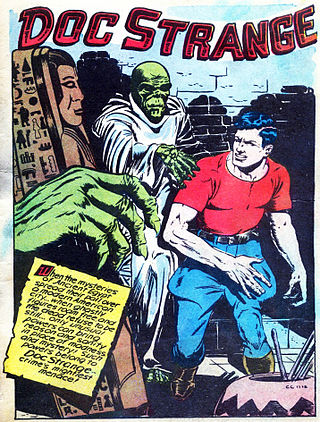
Doc Strange is a Golden Age comic book superhero who originally appeared in Thrilling Comics #1 in February 1940. The character continued in Thrilling Comics until issue #64. He also appeared in America's Best Comics #1-23 and 27.

The Shield is the name of several superheroes created by MLJ. Appearing months before Captain America, the Shield has the distinction of being the first superhero with a costume based upon United States patriotic iconography. The character appeared in Pep Comics from issue #1 to #65.
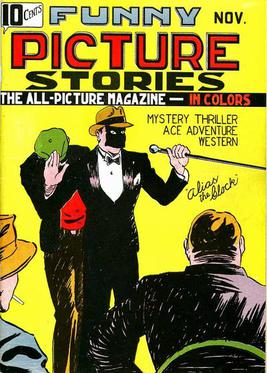
The Clock is a fictional masked crime-fighter character created in 1936, during the Golden Age of Comic Books. He was the first fully-masked hero to appear in American comic books.

Daredevil is a fictional superhero created by Jack Binder, who starred in comics from Lev Gleason Publications during the 1930s–1940s period that historians and fans call the Golden Age of comic books. The character was retroactively established into the Image Universe by Image Comics in the 1990s as its first character. The character is unrelated to Marvel Comics' Daredevil, and recent renditions of the character have often renamed him Doubledare or The Death-Defying Devil to avoid confusion and potential lawsuits.

Wonder Man is a fictional superhero created by American cartoonist Will Eisner, whose only appearance was in the comic book Wonder Comics #1. The character is of some historical significance due to a lawsuit that resulted from his only appearance.

The Comet is a character that first appeared in Pep Comics #1 in January 1940. A little over a year later, the Comet was the first superhero to be killed in the line of duty. He died in issue #17, which also introduced his brother, a brutal hero called the Hangman.
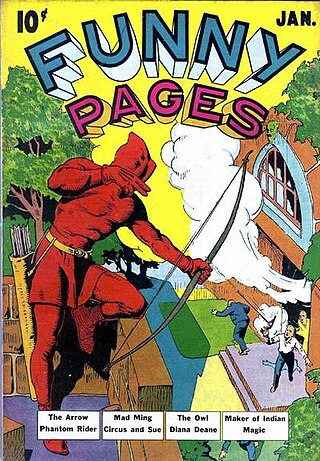
The Arrow is a fictional superhero created during the Golden Age of Comic Books. He was the first superhero published by Centaur Publications.

The Skyman is a fictional comic book superhero that appeared stories during the Golden Age of Comic Books. Created by writer Gardner Fox and artist Ogden Whitney, the character first appeared in the Columbia Comics omnibus title Big Shot Comics #1. He is unrelated to the DC Comics character.
The Green Mask is the name of two comic book superheroes, both published by Fox Feature Syndicate. Both are in the public domain with some of the original stories having been reprinted by AC Comics.

Amazing-Man is a comic book superhero whose adventures were published by Centaur Publications during the 1930s to 1940s in the Golden Age of Comic Books. Historians credit his creation variously to writer-artist Bill Everett or to Everett together with Centaur art director Lloyd Jacquet. Amazing-Man first appeared in Amazing-Man Comics #5 —there were no issues numbered #1–4).

The Bouncer is a fictional superhero who appeared in comic books published by Fox Feature Syndicate. The Bouncer had no secret identity, but was in reality a statue of the Greek mythological figure Antaeus. The statue had been sculpted by Adam Anteas, Jr., a descendant of the very same legendary figure. Like his Greek ancestor, Anteas Jr. gained power when in contact with the earth. Anteas Jr.'s power was that he bounced back whenever he struck the ground; the harder he hit, the higher he bounced. Like his ancestor, he lost his power when out of contact with the ground.
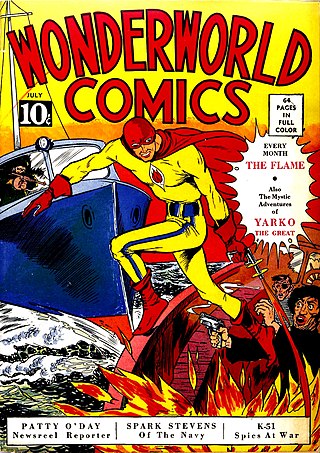
The Flame is a superhero that appeared in American comic books published by Fox Feature Syndicate. The Flame first appeared in Wonderworld Comics #3 and was created by writer Will Eisner and artist Lou Fine. The Flame became Wonderworld's primary character.

Shock Gibson is a fictional comic book superhero who first appeared in Speed Comics #1, from Brookwood Publications. He was created by artist Maurice Scott, who drew it through issue #11, and an unknown writer. His 1939 introduction makes him one of comic books' earliest superheroes. He also appeared in All-New Comics #8.
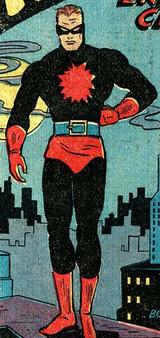
Firefly is a superhero created by Harry Shorten and Bob Wood for MLJ Comics in 1940. He first appeared in Top-Notch Comics #8. Artist Warren King and writer Joe Blair loaned their talents to many of the Firefly's installments.
Minimidget, the Miniature Man is a superhero who first appeared in Centaur Comics. Minimidget was written and illustrated by John F. Kolb (1913–2004). After Centaur's collapse in 1942, Minimidget is now in the public domain.

The Target and the Targeteers are fictional characters, a trio of superheroes who first appeared in 1940, in Target Comics from Novelty Press.
Yank & Doodle is a pair of superheroes who first appeared in the Prize Publications title Prize Comics in August 1941. They were revived by Dynamite Entertainment in the 2000s.
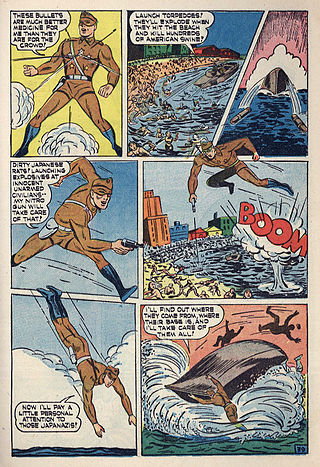
The Unknown Soldier is a fictional superhero character who first appeared in Our Flag Comics #1 from Ace Comics. The comic was devoted to patriotic superheroes, and also included Captain Victory and the Three Cheers.
The Little Wise Guys is a group of fictional characters, created by Charles Biro, who first appeared in comic books from Lev Gleason Publications in the 1940s and Image Comics in the 2010s.
Supersnipe is a fictional character who appeared in a series of comic books published by Street & Smith from 1942 to 1949. Supersnipe was the imagined alter ego of Koppy McFad, "the boy with the most comic books in the world." He was created by writer-artist George Marcoux, who had previously assisted Percy Crosby on the comic strip Skippy.















